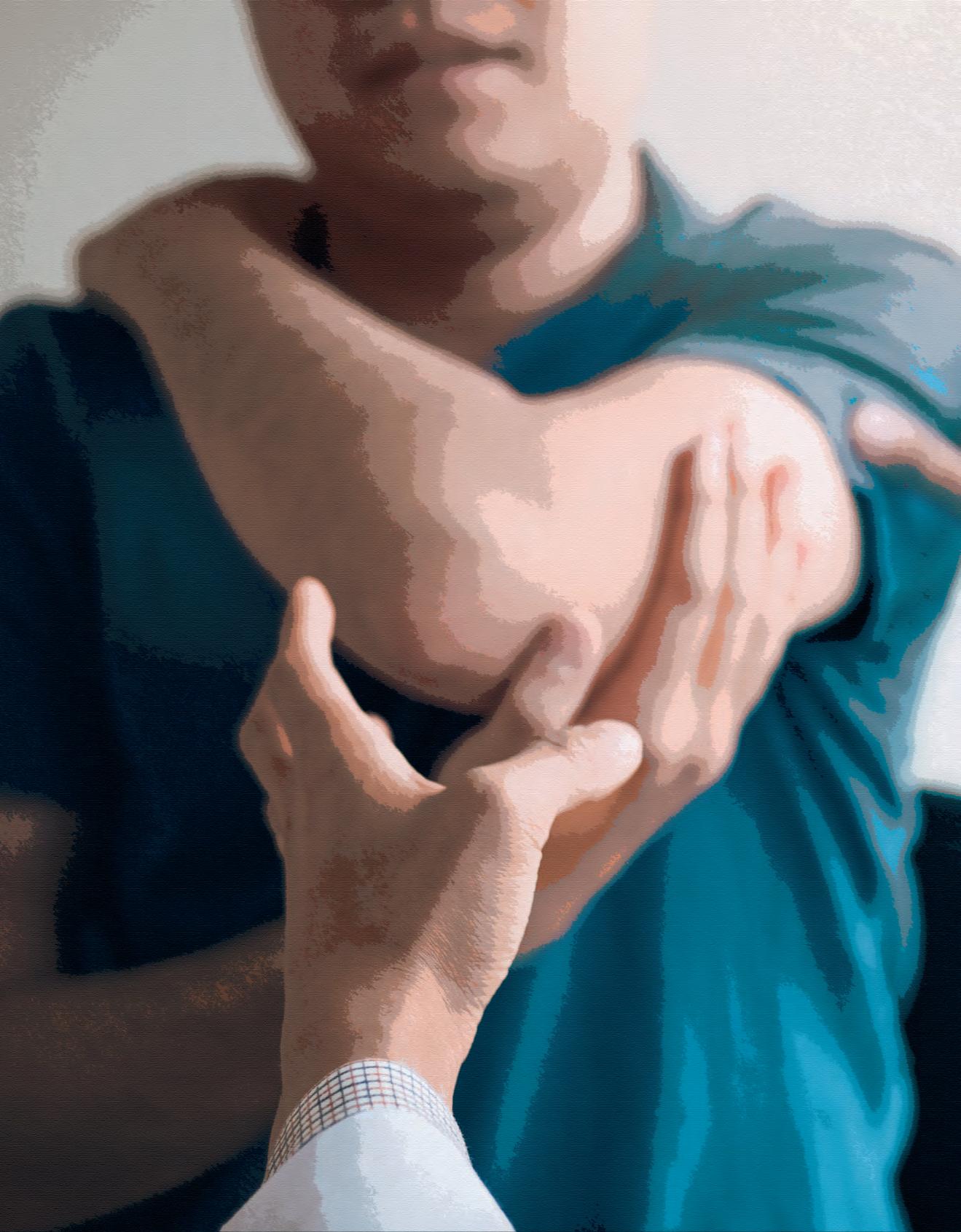
9 minute read
Dr. Atwood
by Will Beachy
In the back seat with my brothers, I was just happy to be on a trip—a rare vacation from the farm, where there were always chores to be done— milking the cows every morning and evening, feeding the hogs, and filling the racks with hay for the cattle. The job of cleaning out the cow stable, or worse, the hog house, was a chore reserved for Saturdays when we weren’t in school. This Saturday was different; we were all piled into our red ’57 Plymouth, headed for Dr. Atwood’s office, 80 miles away. We had made this trip many times over the years. Dr. Atwood was a chiropractor, and it seemed my parents trusted him more than they trusted our town’s medical doctor. Dr. Atwood worked outside of the medical community’s accepted standards, which was probably why my parents were drawn to him. They believed he had knowledge about conditions medical doctors were not trained to recognize; for example, the dangers of cooking with aluminum pots and pans, or eating from Melmac dishes. Dr. Atwood was clear; aluminum could get into your system—the worst place for it to get into—and Melmac could accumulate in your nerves, accounting for a multitude of ailments, ranging from general malaise to malignant tumors.
Advertisement
Dr. Atwood was no ordinary chiropractor; he treated a broad range of maladies with his spinal manipulations, mysterious machines, and natural organic food supplements. His patients tended to trust his expertise with an almost religious fervor. Of course, the medical establishment criticized Dr. Atwood’s methods, but it was easy to see why. Pure and simple, the American Medical Association (AMA) wanted to have the monopoly on medicine. Not only that, medical doctors prescribed synthetic drugs to their patients. There wasn’t anything worse than synthetic; even the word had a sinister sound.
But as I grew older, I became skeptical about Dr. Atwood’s legitimacy. As a junior in High School I felt I knew some things about science, and I had observed some things Dr. Atwood did that did not seem rational. More importantly, I didn’t want my classmates to know my parents took me to a chiropractor. It was widely known that Amish folks in our community were regulars with Dr. Atwood, and the last thing I wanted was to be associated with the Amish, even though that association was an indelible part of my identity. Although my parents left the Amish church soon after I was born, they retained the commonly held view among Amish people that public schools were a corrupting influence. For that reason, they had sent us to a private country school, heavily populated by Amish kids. After the 10th grade, my parents allowed me to attend public high school, which at once terrified and excited me. I longed for the sophistication and worldliness of my classmates.
I did not openly share my skepticism about Dr. Atwood with my parents, especially not with Dad. His trust in Dr. Atwood was not to be questioned. Several of our neighbors gave testimonies supporting Dr. Atwood’s ability to heal chronic ailments untouched by conventional medicine. One woman believed he had eradicated her cancer. I knew it would not be wise for me to suggest that our trusted family friends were dupes, or worse, insinuate that Dad was one. After all, Dr. Atwood had made it clear that he was a devout Christian, pretty much a clincher that he was not a fraud as far as Dad was concerned.
Now, on the outskirts of Bloomington, we were arriving at Dr. Atwood’s office, which didn’t look much like a doctor’s office at all; it looked more like a regular family residence. Its big screened-in front porch served as a waiting room. The thing I liked about it in my younger years was the ample supply of Western-themed comic books, such as The Lone Ranger, Roy Rodgers, Gunsmoke, and the like. Dad did not allow us to have comic books at home, but he somehow overlooked this prohibition at Dr. Atwood’s. Even now, I still liked to look through comic books.
Dr. Atwood’s initial routine was to give me an “adjustment” on his exam table, a mauling kind of manual manipulation that brought me to a place between bliss and pain. Part of the adjustment included cracking my spine and neck; this he would accomplish by distracting me with a question, and while I was thinking up a response he would startle me with a short vigorous thrust that yielded a satisfying, cracking pop. Then it was time for a session with the mysterious Machine in Dr. Atwood’s office. Dr. Atwood’s nurse, Joanne, would show me to a dressing room where I removed my shirt and put on a gown.
The Machine was essentially a large desk with a hutch-like structure on top, covered with a bewildering array of dials and switches. Embedded in the horizontal surface of the desk was a small rectangle of glass, next to which was a small shaker of baby powder. A black cable protruded from the side of desk and was attached to a metal brass-colored loose mesh. I remember the chill of the mesh on my skin when Dr. Atwood positioned it under my smock. When everything was properly hooked up, Dr. Atwood would sit back in his chair, sprinkle baby powder on the glass rectangle, and rub it with two fingers, simultaneously turning dials and snapping switches. This process would continue for a few minutes, accompanied by the rhythmic squeaking sound of rubbed powder and clicks of turned dials. Occasionally, Dr. Atwood would pause with a seemingly puzzled “Hmmm,” and then continue to rub the powdered glass. Finally he would sit back, wipe the powder from his fingers with a tissue, clasp his hands, and pronounce the verdict:
“Do you use aluminum cookware? Your boy’s spleen is loaded with aluminum!”
The question was asked with incredulity. It did not take many such proclamations for our house to be free of aluminum cookware. The good news was that aluminum could be cleared from the spleen with a week of treatments every day, which consisted of attachment to a much smaller bedside version of the Machine for 30-minute sessions; this smaller machine had only one dial and a glowing red indicator light. These sessions took place in a small cubicle with a drawn curtain. I could read several comic books in 30 minutes.
It wasn’t only aluminum the Machine could eradicate. It could rid victims of dyes, plastics, chocolate, and excessive sugar, among other undesirable substances. It seemed to me the tastier a thing was the more likely its detection and banishment. Some items were impractical to ban, such as bread, butter, eggs, and milk. These could, however, be brought in to Dr. Atwood’s office where they could be “neutralized” by a special Neutralizer, a device that rendered the offending substances harmless. The Neutralizer could handle even bulky items. For example, my parents, apparently at wit’s end in dealing with the stubbornness and disobedience of my youngest sister, brought her in to be neutralized. Perhaps fortunately, the neutralizer was no match for her, and she emerged from it with her qualities intact.
Now, today, Dr. Atwood performed my usual manual “adjustment,” after which he attached me to the big Machine. He rubbed the powdered glass and turned several dials, but then prematurely, it seemed, stopped and frowned. He wiped the powder from his fingers, sprinkled more on the glass rectangle, and resumed the process. Again he stopped, this time with an air of finality. He leaned back in his chair and with great solemnity pronounced,
“This boy has TB in four sections of the heart!”
This declaration sounded pretty serious to me, but somehow did not unduly alarm me. I felt completely fine—no aches, no discomfort of any kind. Nevertheless, I figured something horrible was lurking in the background, waiting to declare itself. My parents looked bewildered and shocked.
Thinking back, surely there must have been a kernel of skepticism in my parents; they knew tuberculosis did not randomly infect a person without exposure to someone with the disease. But my parents did not question Dr. Atwood that day. The good news was that Dr. Atwood could get rid of “TB,” never mind its pervasive residence in four chambers of my heart. It would require two weeks of treatment, five days a week for an hour each day. In the meantime, I was not to engage in any strenuous activity, or lift anything heavy. This precaution was a silver lining in the cloud of my diagnosis; no chores for me perhaps? At least nothing strenuous! It did not occur to me right then that this limitation would obviously translate into no participation in the sports I loved—no basketball, no baseball, no football. Further, I would have to explain my frailty to my high school PE teacher, a gruff, intimidating man with little sympathy for weaklings. Plus, I would suffer the indignity of being seen as a wimp in the eyes of my classmates.
Now, after I was dressed and ready to leave with my parents, Dr. Atwood suddenly remembered he had forgotten to prescribe an important supplemental herb that would add to the effectiveness of my treatments. He, of course, had the supplement on hand and pulled a bottle off the shelf. But there was complication.
“Oh-oh,” he said, “I need to check to see if these pills ‘agree’ with him. We’ll need to hook him back up to the Machine.”
Agree with the workings of my “system,” of course. But since I had already put on my shirt, Dr. Atwood took an astounding shortcut. He wrote my name on a piece of paper and clipped it to the same wire that had earlier been attached to the mesh on my chest. Then he placed the bottle of pills in a recessed cup next to the glass rectangle on the Machine. He shook some baby powder on the glass, rubbed it, and turned a few dials. After a few seconds he stopped and looked up, delighted.
“It agrees with him—he’s good to go!”
I had already thought Dr. Atwood’s practice was dubious, but now the frail thread connecting it to even the faintest bit of logic in my mind came apart forever. Here was proof of his quackery. I looked at Dad and saw a trace of astonishment, but he said nothing. I have to believe, however, that Dad’s trust in Dr. Atwood was shaken that day. Nevertheless, for the next week I was allowed to forgo farm chores and hard work—and I savored every moment. At the same time, I couldn’t help feeling a bit foolish, especially when I had to tell the PE coach my story. But after a week, my parents apparently thought enough was enough, and I was soon conscripted back into the routine of farm work. The “TB” never did progress.
WILL BEACHEY is an emeritus professor of the Respiratory Therapy Department from 1990 - 2015 at the University of Mary in Bismarck, ND. Now retired, he’s trying his hand at writing in an altogether different vein - in this case, a story based on a childhood memory while growing up on a farm in central Illinois. Will lives with his wonderful wife, Ruth, in Hudson, WI.









